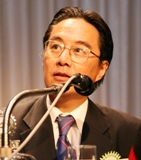��Outer Gardens of the Imperial Palace, the precious source of greenery and water in the center of Tokyo��
October 14, 2009
Mr. Masaki Suzuki
Director, Environmental Management Bureau, Ministry of the Environment
 ��The Environmental Management Bureau is engaged in wide-ranging tasks of nature conservation, such as bio-diversity preservation, national park management, protection of rare species and extermination of introduced species. We also manage three national gardens, which are the ��Outer Gardens of the Imperial Palace,�� ��Kyoto Imperial Garden�� and ��Shinjyuku Gyoen Garden.�� These gardens used to be private gardens of the Imperial families before the War, but have been open to the general public since December 1947.
��The Environmental Management Bureau is engaged in wide-ranging tasks of nature conservation, such as bio-diversity preservation, national park management, protection of rare species and extermination of introduced species. We also manage three national gardens, which are the ��Outer Gardens of the Imperial Palace,�� ��Kyoto Imperial Garden�� and ��Shinjyuku Gyoen Garden.�� These gardens used to be private gardens of the Imperial families before the War, but have been open to the general public since December 1947.
1.��Outline of the Outer Gardens of the Imperial Palace
��The Imperial Outer Gardens are rich in scenic and historic interest, including the Double Bridge, Sakuradamon Gate or Wadakura Fountain Park. Kitanomaru, located at the northern side of the Imperial Palace, has been open to the public since 1969 as Kitanomaru Park. Beautiful 12 moats, banks and stone walls surrounding the Palace also constitute the Outer Gardens.
��
The Imperial Palace and the Outer Gardens are a symbolic space for the Japanese.��Many people pay visits on various occasions, such as New Year��s Day or memorial events, and are impressed by its dignified and solemn atmosphere. We can also deepen understanding on the history of Edo Castle by observing various cultural properties.
��This spacious area of greenery and water also plays environmental functions, such as serving as habitats for many forms of life or being a cool spot to alleviate the heat-island phenomenon in summer at the center of the big city.
2.��Outline of the moats in the Outer Gardens
��The moats run throughout the Palace grounds. The highest point is where the Hanzomon Gate stands. The water runs in two directions; one flows into Hibiya moat via Sakurada moat anticlockwise, while the other flows into Hibiya moat via Chidorigafuchi clockwise.
��Water qualities of the two currents differ from each other. Sakurada moat has the best water quality, as good as Lake Shinji or Lake Suwa, while Chidorigafuchi has the worst water quality. This spot is well-known for beautiful cherry blossoms, but it has problems when it comes to water quality. There are several factors: one is the sewage outlet located at the south end which overflows on rainy days, another being the suspended water intake from the Tama aqueduct since the mid-1960s, and depending solely on rainwater. Garbage and fallen leaves also pollute the water, causing water bloom which stinks in summer.
��We are taking various measures to improve the water quality. We installed the water purification facility at Hibiya moat, to pump up water, remove flotage through filtration, and to draw off clean water from Hanzomon Gate. We also dredge sludge accumulating at the bottom of the moat or dry up the water.
��The moats are man-made constructions dating back 400 years ago. Today, they are harmonized with nature over many years. The moats are our valuable source of historical heritage and beautiful landscape, and they also provide precious habitats for the living things. Some creatures identified as endangered species and recorded in our Ministry��s Red Data Book live here. Waterfowls come flying during the winter, and little spotbill ducks are so adorable.
��As we celebrate the 20th Anniversary of the Emperor��s reign, various measures are taken in collaboration with related institutions to clean the water of the moats. The Tokyo Metropolitan Government is taking the initiative to redress the problem of overflowing sewage, which is scheduled to complete by 2015. Our Ministry established the investigative commission in 2008-2009, which examined how to manage the moats from various perspectives, such as survey on existing water purification facilities, study on the rain and sewage waters, and schedule for piping repairs. The project for replacing the sewerage system will start in 2010, and the actual work will be done in 2013-2015.
��Let me express my gratitude to the Tokyo Rotary Club for supporting the water purification endeavor by using carbon fibers. We are determined to continue our efforts in improving the water quality.
3. The Biodiversity Treaty
��At the end, I��ll touch upon the Biodiversity Treaty, an international treaty with an objective to 1) preserve, at the maximum level, all inclusive biodiversity on this earth, together with their habitat, 2) achieve sustainable use of biological resources and 3) equally divide the gains from those resources. The treaty was adopted at Nairobi in May 1992, and 157 countries, including Japan, signed the treaty during the Earth Summit in June 1992. 194 countries are expected to participate in the COP10 (10th Conference of the Parties to the Convention on Biological Diversity) in October 2010 at Nagoya, Aichi Prefecture, a three-week conference with around 10,000 participants from governments, business community, NGOs and local public entities. Japan will host and chair this big international event.
��Unlike the issue of global warming, where the arguments of the developed and developing nations often conflict, the issue of biodiversity tries to seek ways the developed and developing nations can work together to preserve the environment and species on the verge of extinction.
Let me conclude my speech by asking for your support to the coming COP10 conference.